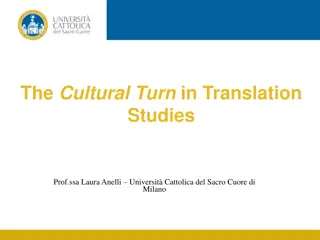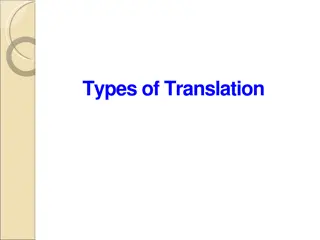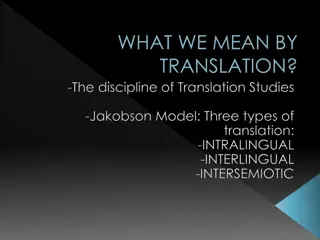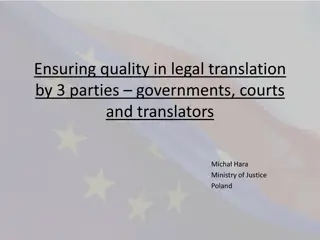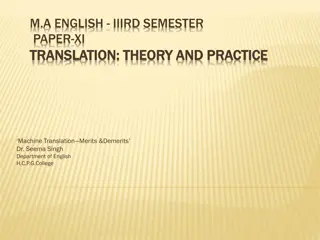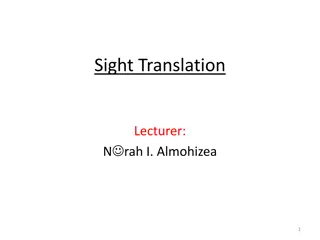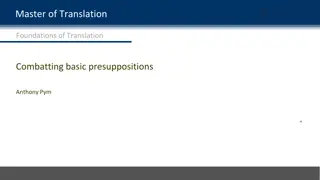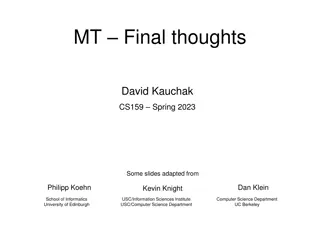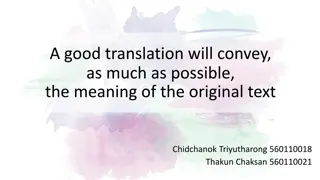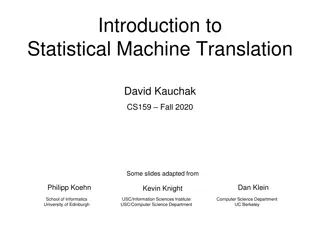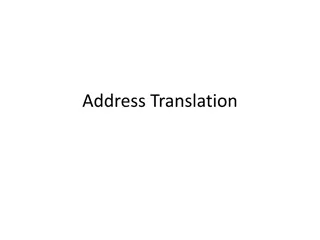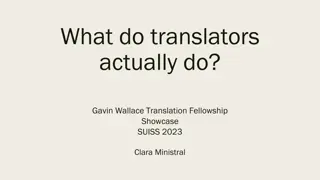Exploring Translation Techniques and Levels
Delve into various translation techniques such as amplification, false friends, explicitation, and generalization, as exemplified by Vinay and Darbelnet. Discover the concept of loss, gain, and compensation in translation, along with the different levels of translation, including lexicon, syntactic structures, and message utterance. Learn about the difference between servitude and option in translation procedures and the importance of option for stylistic changes.
Download Presentation

Please find below an Image/Link to download the presentation.
The content on the website is provided AS IS for your information and personal use only. It may not be sold, licensed, or shared on other websites without obtaining consent from the author.If you encounter any issues during the download, it is possible that the publisher has removed the file from their server.
You are allowed to download the files provided on this website for personal or commercial use, subject to the condition that they are used lawfully. All files are the property of their respective owners.
The content on the website is provided AS IS for your information and personal use only. It may not be sold, licensed, or shared on other websites without obtaining consent from the author.
E N D
Presentation Transcript
Lecture Four Lecture Four
Exploration: Procedures There are a large number of other techniques exemplified by Vinay and D arbelnet. Among those that have maintained currency in translation theor y are the following: Q Amplification: The TL uses more words, often because of syntactic exp an- sion, e.g. the charge against him > the charge brought against him. T he opposite of amplification is economy. Q False friend: A structurally similar term in SL and TL which deceives the user into thinking the meaning is the same, e.g. French librarie means not English library but bookstore. Q Loss, gain and compensation: Lost in translation has become a popul ar clich , partly thanks to the film. Translation does inevitably involve so me loss, since it is impossible to preserve all the ST nuances of meaning a nd structure in the TL. However, importantly a TT may make up for ( comp ensate ) this by introducing a gain at the same or another point in the tex t.
Q Explicitation: Implicit information in the ST is rendered exp licit in the may occur on the level of grammar (e.g. English ST the doctor explicated as masculine or feminine in a TL where indication of gender is essential), semantics (e.g. the explanation of a S T cultural item or event, such as US Thanksgiving or UK April Fool s joke), pragmatics (e.g. the opaque and culturally locate d US English idiom it s easy to be a Monday morning quarterb ack) or discourse. obligatory explicitation has often been suggested as a cha racteristic of translated language. Q Generalization: The use of a more general word in the TT. E xamples would be ST computer > TT machine, or ST ecstatic > TT happy. Again, generalization has been suggested as anoth er characteristic of translation. TT. This Non-
Levels of translation The seven 30) as operating on three levels. These three levels reflect the main structural elements of the book. They are: (1) the lexicon; (2) syntactic structures; (3) the message; in this case, message utterance and its metalinguistic situation or context. Two further terms are introduced which look above word level. These are: (1) word order and thematic structure (2) connectors: These (also, and, but, and parallel structures), discourse markers (however, first . . .), deixis (pronouns and demonstrative pron ouns such as she, it, this, that) and punctuation marks. Such levels of analysis begin to based analysis considered this book, so we shall not consider them further here. However, one further important paramet er described by Vinay and Darbelnet does need to be stressed. This is the difference between servitude and option: main translation procedures are described (1995: 27 is used to mean approximately the are cohesive links point to the text-based and discourse-
ons ence between the two language systems. Q Option obligatory changes that may be due to the translator s own s tyle and preferences, emphasis. This could be the decision to amplify or explicate a general term (e.g. this > this problem/ question/issue) o r to change word order when translating between languages that permit flexibility. Clearly, this is a crucial difference. Vinay and Darbelnet stress that it is option, the realm of stylistics, that should be the translator s main concern. The role of the translator is then to choos e from among the available options to express the nuances of the message . due to a differ- refers to non- or to a change in
Catford and translation shifts Translation shifts are linguistic changes occurring in translation of ST Although Vinay and Darbelnet do not use the term, that is in eff ect what they are describing. The term itself seems to originate in Catford s A Linguistic Theory of Translation (1965), where he devotes a chapter to the subject. Catford follows the Firthian and Hallidayan linguistic model, w hich analyses language as communication, operating functiona lly in context and on a range of different levels (e.g. phonology, graphology, grammar, lexis) and ranks (sentence, clause, group, word, morpheme, etc.).5 As far as translation is concerned, Catford makes an importan t distinction between formal correspondence and textual equiv alence, which was later to be developed by Koller. to TT.
ture, etc.) which can be said to occupy, as nearly as pos sible, the same place in the economy of the TL as the given SL category occupies in the SL . Q A textual equivalent is any TL text or portion of text whi ch is observed on a particular occasion . . . to be the equiv alent of a given SL text or portion of text (ibid.). Thus, formal correspondence is a more general syst em-based concept between a pair of languages while textual equivalence is TT pair. When the two concepts diverge, a translation sh ift is deemed to have occurred. In Catford s own words , t ranslation shifts are thus departures from formal correspondence in the process of going from the SL to the TL . tied to a particular ST
(1) A level shift would be something which is expressed by grammar in one language and lexis in another. Q cases where the French conditional corresponds to a lexical item in English. (2) Most of Catford s analysis is given over to category shifts. These are subdivided into four kinds: (a) Structural shifts: These are said by Catford to be the most common and to involve mostly a shift in gram matical structure. e (b) Class shifts: These comprise shifts from one part of speech to another (c) Unit shifts or rank shifts: These lent in the TL is at a different rank to the SL. Rank here refers to the hierarchical linguistic units of sentence , clause, group, word and morpheme. (d)Intrasystem shifts: These are shifts that take place when the SL and TL possess approximately correspondi ng systems but where the translation corresponding term in the TL system . Examples given between French and English are number and article sy stems although similar systems operate in the two languages, they do not always correspond. are shifts where the translation equiva- involves selection of a non-
Catfords book is an important attempt to systematically apply advanc es in linguis- tics to translation. system shifts betrays the weaknesses of his approach. From his comparison of the use of F rench and English article systems in short parallel texts, Catford concl udes: However, his analysis of intra- some of
that French le/la/les will have English the as its translation equivalent with probability, supporting his statement that translation equivalence does not entirely match formal correspondence . This kind of statement of probability, which char- acterizes Catford s whole approach and was linked to the growing interest in machine translation at the time, was later heavily criticized by, among others, Delis le for its static contrastive linguistic basis. Revisiting Catford s book twenty years after publication, Henry considers and large of historical academic interest only. He does, however, point out the usef ulness of Catford s final chapter, Of particular interest is Catford s assertion that translation equivalence depends on c ommunicative features such as function, relevance, situation and culture rather th an just on formal linguistic criteria. However, as Catford himself notes, deciding what is functionally relevant in a given situation is inevitably a matter of opinion . Despite the steps taken by Catford to consider the communicative function of the SL i tem and despite the basis of his terminology being founded on a functional approach t o language, the main criticism of Catford s book is that his examples are almost all idea lized (i.e. invented and not taken from actual translations) and decontextualized. He d oes not look at whole texts, nor even above the level of the sentence. the work to be by on the limits of translatability.
Other writing on translation shifts in the 1960s and 1970s from the then Czechoslovakia introduced a lit erary aspect, that of the expressive function or style of a text. Among these, Jir Lev (1926 Option, markedness and stylistic shifts in translation 1967) s groundbreaking work on literary translation links into the tradition of the Prague School of structur al linguistics. It was mainly known in western Europe through its German translation: Theorie einer Kunstga ttung (Lev 1969) and its continuing relevance can be gauged by its more recent translation into English (Le v 2011). Lev looks closely at the translation of the surface structure of the ST and TT, with particular att ention to poetry translation, and sees literary translation as both a reproductive and a creative labour with the goal of equivalent aestheticeffect . he question of stylistic shifts in translation has received greater attention in more recent translation theor y. This has to do with: (1) interest in the intervention of the translator and his/her relationship to the ST author as exemplified through linguistic more sophisticated computerized tools to assist analysis. The first point is typified by two papers, by Giulia na Schiavi and Theo Hermans, that appeared 1990s. Schiavi borrows a schema from narratology to discuss an inherent paradox of translation: choices; and (2) the development of together in Target in the mid-
[A] reader of translation will receive a sort of split message c oming from two different addressers, both original although in two different nating from the author which is elaborated and mediated b y the translator, and one (the language of the translation its elf) originating directly from the translator. The mix of authorial and translatorial message is the result of conscious and making from the translator. This mix, and the translator s discursive presence , as Hermans (1996) puts it, is conveye d in choices that appear in the TT. Of course, for many TT read ers the TT words not only represent but are the words of senses: one origi- unconscious decision- the linguistic
For the lator, rather than the ST author, are recoverable from anal ysis of the TT choices. Such analysis has been termed tra nslational stylistics by Kirsten Malmkj r (2003). It has als o been advanced by based methods. These have attempted to identify the ling uistic fingerprint of the translator by comparing ST and TT choices against large representative collections of electro nic texts the SL and TL. So, for example, Baker (2000) compares th e frequency of the lemma (forms of the verb) SAY in literar y translations from Spanish and Portuguese (by Peter Bush ) and Arabic (by Peter Clark), and uses the British National Corpus of texts6 as a reference to judge their relative imp the style analyst, the intentions question is how far and of the trans- the use of corpus- in
The difficulty in distinguishing between those shifts that a re effects of the SL and those that are the result of transla tor s linguistic preferences relates to the difference betwe en Vinay and Darbelnet s servitude and option. Despite th ese problems, there are some important features that can be investigated by such studies. Most important, pe rhaps, is the analysis of the stylistic choices in TT and ST. Markedness relates to a ch oice or choices that stand out as unusual and may come to t he reader s attention. So, in English a sequence such as Challenging it is. Boring it isn t is marked because of the unusual word order with the adjectives in first position. T he key is to look for the reason behind the markedness. I n this case, the wording is from a job advert (to recruit po lice in London), so the markedness functions to draw the relative markedness of patterns of
In translation, it may usually be expected that a marked ite m in the ST would be translated by a similarly marked ite m in the TT but this is not always so. Some work has investigated the possibility that translation may be less marked: Kenny (2001), for instance, looks at the translatio n of creative lexical items and neologisms German literary texts, Condit s (2004) esis . On the other hand, Saldanha (2011) investigates fe atures such borrowings that make a particular translation distinctive. S ome of my own work (e.g. Munday 2008) has also examine d the distinctiveness of a specific translator s work. So, comparing patterns in the work of the translator Harrie t de On s, I identify: from similar to Tirkkonen- hypoth- unique items as italicized
The interesting point is to hypothesize the motivation be hind the selections. Most crucially, the question is how fa r the unconscious (as well as conscious) choices may in fac t be due to factors in the translator s environment, includi ng education and the sociocultural and political context in which they operate. a translator s choice reveal a personal ideological orienta tion? Or one that is promoted which they live? May by the society in




